PTE
Speaking
1) Read Aloud
Finish in half time…not full time..if they ask to read for 40 sec’s just finish in 20 sec’s…no pauses between . or , …speak as fast as possible…
Words Pronounce:
Combustion — Combuschon
According — Telugu AAcording
Subtle — Sutle
Almond — Amond
Asthma — Asma
Debris — Debri
Statistics — Staytistics
Determine — Determin
After ‘C’ if we have ally then pronounce ly
Basically — Basicly
Physically — Physicly
Mentally — Mently
Mechanically — Mechanicly
Automatically — Automaticly
Statistically — Statisticly
2) Repeat Sentence
Repeat all words…no shortcuts…just practise…hear and repeat sentence.
3) Describe Image
No pauses at full stop and commas..Speak min 3-5 sentences..Speak min 25 secs to 39 secs and click next before 40 sec…don’t forget to read all labels and numbers in second sentence…speed and clarity is important…no score for grammar, no score for meaning…even meaningless sentences get score…use comparison in the last statement like highest/ lowest…increase/ decrease…rise/ fall…most importantly use numbers which are printed, never go with own calculation…
Images will be two types: 1) Statistical (with numbers) 2) Non-Statistical (without numbers)
Statistical (with numbers) is again divided into No or Single period (NP/ SP) and Multiple period (MP)
Note: Line graphs are always MP (Multiple period)
1) NP/ SP: In the first 25 secs, take the highest number, understand all about it and describe it on full sentence..its ideal to write this sentence on paper…
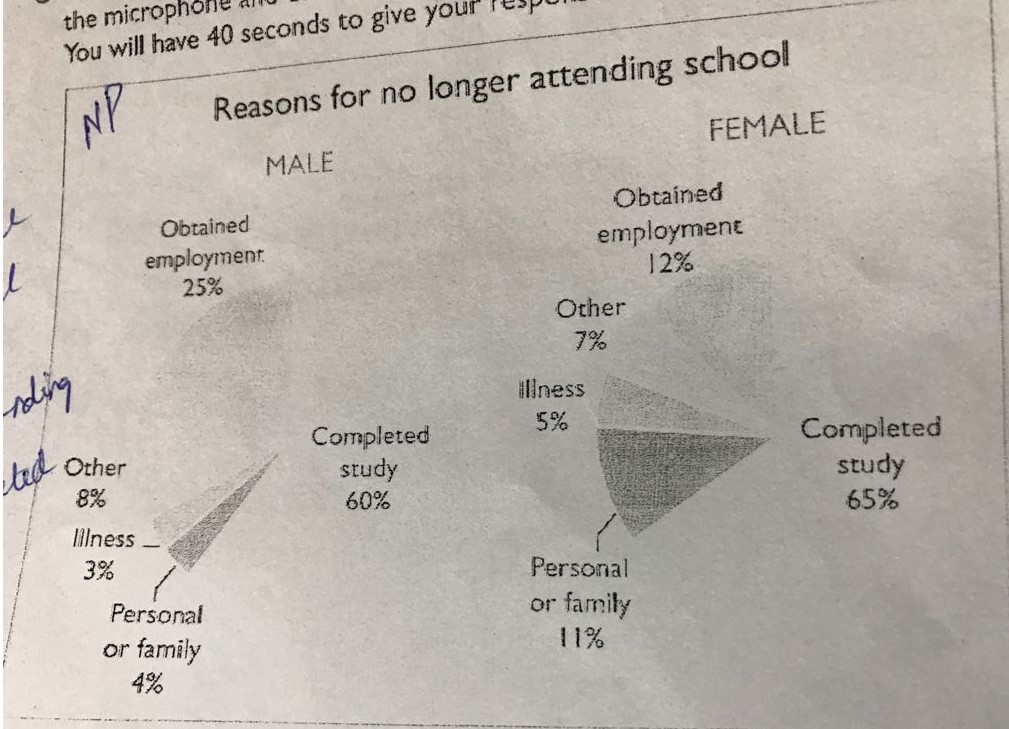
Speaking page 17 image 2 (above image) : 65 percent of females are no longer attending school since they have completed their study.
Sentence1:
The given line graph/ bar chart/ table/ pie chart/ diagram/ picture/ figure, comparatively illustrates/ depicts/ provides/ reveals/ presents/ displays the information about heading (the reason for no longer attending school) in/ among (among) domains/ time (males and females).
Sentence2:
On the whole, it is evident from the diagram that, (the reasons include completion of study, obtaining employment, personal or family factors, illness as well as others), (whereas the values include 65 percent, 12 percent, 7, 5, 11, 60, 25, 8, 3 percent and 4 percent) {here no need to repeat percent for all numbers just tell on first two and last two and before last value ‘and’ is important}
Sentence3: Write this sentence during preparation time
A(a)ccording to the statistical data, in/ among (among), domain1 {read first sentence which was written earlier during prep time} (65 percent of females are no longer attending school since they have completed their study) which is the highest, while, (describe lowest — only 5 percent are not going to school due to illness) which is the lowest.
*If its only one pie chart we can stop here…
Sentence4:
Similarly (use this if the highest value is same as domain1)/ On the other hand, in the case of, domain2, (60 percent of males are not attending school since they have completed their study), which is the highest, while, (lowest – only 3 percent are not going to school due to illness), which is the lowest.
2) Multiple periods
First identify/ write domains…On X-axis you will always find time/ periods like Jan-Dec or Mon-Sun or Years (2000, 2005, 2010, 2015) and on Y-axis we will find values/ units. Make use of words rise/ fall, increase/ decrease, ascend/ descend, hike/ drop, stagnation or stabilization, fluctuation or oscillation. Prefix words slight, marginal, trivial, insignificant, huge, tremendous.
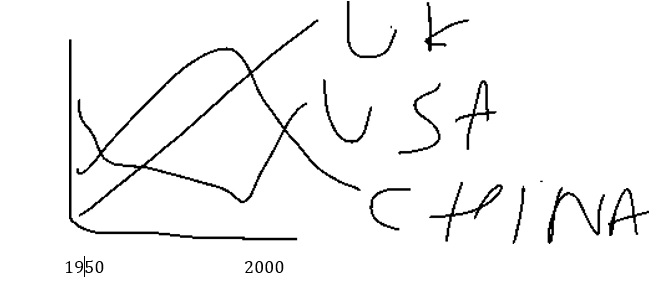
Here domains are UK, USA and China.
UK – Increase; USA – Descend, Stagnation, Ascend; China – Rise, Fall
Sentence1: The given picture comparatively provides the information about heading (trends) in domains (UK, USA and China) during the period (1950 to 2000).
Sentence2: Values on Y-axis and periods on X-axis.
On the whole, it is evident from the diagram that, (the values include {read all values on Y-axis}), (whereas the years include read all values on X-axis — 1950 and 2000)
Sentence3: More details/ Changes in each line/ Write this sentence during preparation time.
A(a)ccording to the statistical data, in, domain1 (UK there was a gradual increase without any stagnation or fluctuation). On the other hand,/ Similarly (here we don’t use similarly), in domain2 (China there was a steady rise followed by a fall). In Contrast/ In the same way (here we use in contrast), in domain3 (USA there was a descend, followed by a stagnation which was finally followed by hike).
Followed >> followed >> followed >> further followed >> finally followed
Examples:
1) There was a series of wild fluctuations/ oscillations.
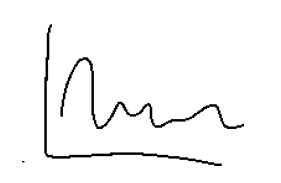
2) It is significant to note that the values of UK were higher than those of USA
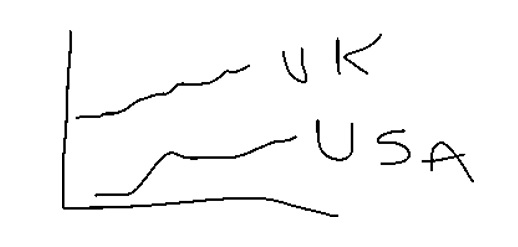
3) Here both the lines act as similar – Gradual increase
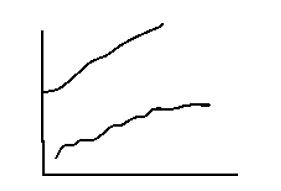
4) Increase and decrease
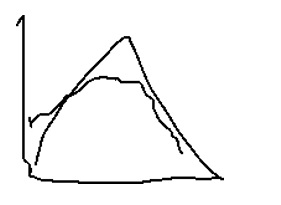
Describe Image:
Example1:
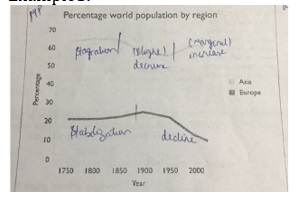
The given picture (line graph) comparatively provides the information about the trends in percentage of world population by region in Asia and Europe during the years 1750 to 2000.
On the whole, it is evident from the diagram that the values include (should not read zero) 10 percent, 20 percent, 30, 40, 50, 60 and 70 percent, whereas the years include 1750, 1800….and 2000. According to the statistical data, in Asia, there was a stagnation, further followed by slight decrease and finally followed by marginal increase. On the other hand, in Europe, there was a stabilization, followed by drastic decline. (Optional: It is also remarkable to note that the values of Asia were higher than those of Europe)
Example2:
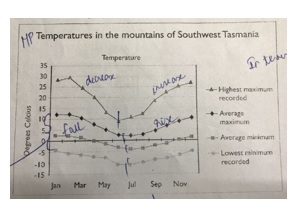
The given picture comparatively provides the information about the temperatures recorded in the mountains of Southwest Tasmania in terms of highest maximum, average minimum, average maximum and lowest minimum during the months January to November.
On the whole, it is evident from the diagram that the values include -15 degrees Celsius, -10 degrees celsius, -5, 0, 5, 10…and -35 degrees celsius, whereas the months include January, March…and November.
According to the statistical data, in highest maximum, there was a decrease, followed by an increase. On the other hand, in average maximum, average minimum and lowest minimum, there was a fall, followed by rise. (Optional: It is also remarkable to note that the values of highest maximum were higher than others).
Example3:
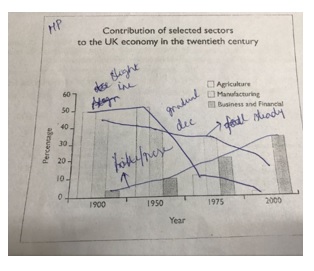
The given picture comparatively provides the information about the contribution of agriculture, manufacturing and business and financial sectors to the UK economy in the twentieth century during the years 1900 to 2000.
On the whole, it is evident from the diagram that the values include10 percent, 20..and 60 percent, whereas the years include 1900, 1950, 1975 and 2000.
According to the statistical data, in agriculture, there was a slight increase, followed by gradual decrease. On the other hand, in manufacturing, there was a steady fall. In contrast, in the case of business and financial sector, there was a rise.
Non-Statistical Images:
Example1:
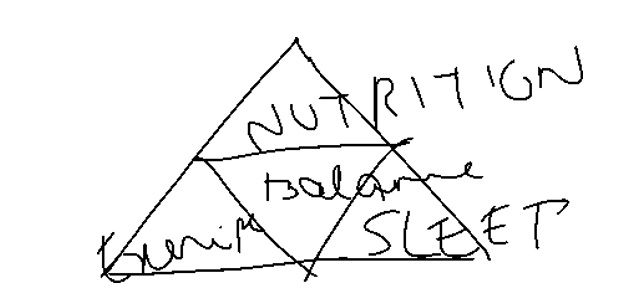
The given picture comparatively provides the information about the stages involved in any name (balance) such as other names (nutrition, exercise and sleep).
On the whole, it is evident from the diagram that in the title (balance), the first stage is nutrition, second stage is sleep and third stage is exercise.
On the other hand, in the title (balance), stage1(nutrition)is followed by stage2(sleep), which is finally followed by stage3 (exercise).
It is interesting to note that clearly all the stages are involved in title (balance) are interlinked with each other such as rest all stages (nutrition, sleep and exercise).
Example2:
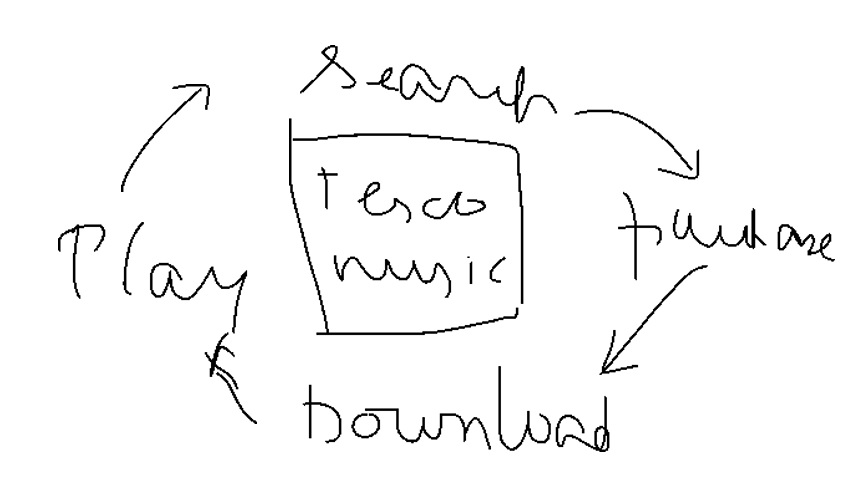
The given picture comparatively provides the information about the stages involved in any name (tesco music) such as other names (search, purchase, download and play).
On the whole, it is evident from the diagram that in the title (tesco music), the first stage is search, second stage is purchase, third stage is download and fourth stage is play.
On the other hand, in the title (tesco music), stage1(search)is followed by stage2(purchase), which is further followed by stage3 (download), whichis finally followed by stage4(play).
It is interesting to note that clearly all the stages are involved in title (tesco music) are interlinked with each other such as rest all stages (search, purchase, download and play).
4) Retell Lecture
Audio will be played for 1-2 mins; 10 secs to prepare; Note/ Capture 30-40 keywords from audio; Speak key words in 25-40 sec; Speak fast and clearly; Speak at least 3 to 5 sentences; No need to be grammatically correct and meaningless sentences are also fine. No need to speak the sentences in sequence but this is not a good practise and no need to conclude using lastly or therefore keywords.
Sample:
Sentence1: In this lecture, the speaker, provides information about, topic.
Sentence2: According to the speech, firstly/ initially/ most importantly, sentence.
Sentence3: In the same way, the author also adds that, sentence.
Sentence4: Secondly/ Besides/ Thirdly, another claim made by the lecturer is that, sentence.
Sentence5: Lastly the Orator winds up the talk, on the note that, sentence.
Key words: (Class room lecture)
Lecture, changes in air pollution, last century, 1950 air pollution is visible in fogs, factories and cause health problem. London 1952 4000 deaths. 1956 clean air cat addressed in Britain, air pollution is big isses, source is cars and lorries, Key factor is vehicle dependant.
Sample Answer: (Class room lecture)
In this lecture, the speaker provides the information about, the changes in air pollution since the middle of the last century. According to the speech, firstly, in 1950 the air pollution is visible in the form of black fog. In the same way, the author also adds that, the pollution was caused by factories. Besides, another claim made by lecturer is that, in 1952, in London, there were four thousand deaths due to pollution and in 1956 the clean air act addressed in Britain. Lastly, the speaker winds up the talk, on the note that, these days air pollution is invisible and caused by cars, lorries and planes and it is still a significant risk to health.
5. Answer Short Questions
Finish in 1 or 2 seconds, don’t leave idle for more than 3 sec’ else it goes to next question. Start with dummy sentences like The answer is–. We can give multiple answers (1 or 2 or 3) if we are not sure on one word. If they ask question as a or b and we are not sure about the answer, then we can speak both a and b with some time difference. See if its singular or plural.
Writing
Usually we get 2-4 questions overall and time limit is 30-70 mins;
6. Summarize written text
Class not attended — Passage with 200-300 words and need to summarize in one sentence. May get 1-3 questions and 10 mins each. 30-50 words only in one sentence, not multiple sentences.
7. Write Essay
200-300 words; 1-3 essays; 20 mins each
The essay should consist of Introduction (50 words) >> Body (Min 2 paragraphs with 50-75 words in each paragraph) >> Conclusion (50 words) = Total 200-250 words.
Introduction and conclusion are important and should not be ignored. Start new para in next line. Do not use: Sub-headings/ Underline/ point wise writing/ shortcuts like don’t, cant, I’ve, exams, congrats/ abbreviations like etc, eg, i.e, viz, asap/ symbols like &, @/ all capitals. For 2nd and 3rd points no need to give examples in the body/ para.
We have 4 types of essays as below:
Type1: Usually give 1 or 2 statements and ask your opinion. Agree/ Disagree
Type2: Topic Advantages & Disadvantages
Type3: List of items – Choose one and support
Type4: Problem – Causes and solution to problem
Type1: Agree or disagree…Unlike type2, here no need to have count difference between advantages/ disadvantages. We can go with 2-2 or 3-3 as well.
Introduction:
It is now-a-days widely contended that, (agree/ disagree theme). But, at the same time, there is also a strong counter-argument amongst some sections of people that, (give opposite theme from above). However, I would personally subscribe to the proposition that, (alternate statement on 1st view).
Para1: Give +ve’s of your option
It is my firm belief that, (your view), mainly because it bestows us with numerous benefits, the most remarkable of which is that, (advantage 1). There are innumerable cases that stand indisputable testimony to what has been claimed here. For instance, (give one example). In the same vein, another significant positive aspect of this is that, (advantage 2). Last, though by no means the least, (advantage 3).
Para2: Give –ve’s of second option
On the other hand, the potential drawbacks involved in (2nd theme) cannot be overlooked. The worst possible loss from this is that, (disadvantage 1). At this juncture, citing an example would be apt to strengthen the claim made here (example). Besides, another perilous implication from this is that, (disadvantage 2). Last, but far from the least, (disadvantage 3).
Conclusion:
Therefore, persuaded by all the points discussed hitherto, and driven by my personal experiences as well, what I would like to state vehemently is that, (alternate sentence from 1st intro or use same sentence as above).
Type2: Never write 2 advantages and 2 disadvantages. There should be difference between them like 2:1 or 3:2 or 1:3.
Sample1: What are the positives and negatives of being in touch with the outside world 24 hrs a day via mobile phones, internet and social networking sites?
Sample2: What are the advantages for the theatre studies students of learning the plays and literature written centuries ago? Are there any problems in it?
Sample3: Increasing number of people are going abroad for studies and living. What are the benefits and loses in doing this.
— Identify/ Understand the topic…often the topic starts with ing form – [being in touch with the outside world 24 hrs a day via mobile phones, internet and social networking sites] or [learning the plays and literature written centuries ago] or [going abroad for studies and living]
— Think of alternatives – [going to foreign countries for education and livelihood] or [heading overseas in pursuit of higher education as well as better life] or [being in contact with the external world round the clock using communication technologies]
Introduction:
(Theme) is relatively a new concept. But in recent times this trend has gained momentum. However, there are both advantages and disadvantages to this practice.
Para1: Advantages
The virtues bestowed by (theme) are aplenty. The most remarkable merit to this is that, (advantage 1). There are innumerable cases that stand indisputable testimony to what has been claimed here. For instance, (example). In the same vein, another significantly positive aspect of this is that, (advantage 2). Last, though by no means the least, (advantage 3).
Para2: Disadvantages
On the other hand, the potential drawbacks involved in (2nd theme) cannot be overlooked. The worst possible loss from this is that, (disadvantage 1). At this juncture, citing an example would be apt to strengthen the claim made here (example). Besides, another perilous implication from this is that, (disadvantage 2). Last, but far from the least, (disadvantage 3).
Conclusion:
Therefore, persuaded by all the points discussed hitherto, and driven by my personal experiences as well, what I would like to state vehemently is that, (alternate sentence from 1st intro or use same sentence as above).
Type3: Same as Type1 template..choose one item and support your views.
Below questions asked many times:
1. There have been many inventions in the twentieth century such as computers, airplanes and anti-biotics. Which of them, do you think, is the greatest invention? Why?
2. As part of your academic research, if you have to study climate change in an area, which area would you choose? Why?
3. Government, Individual, Corporates – Who among them is most responsible for the climate shift that is threating the world? Why?
— Alternate sentences: Computers are greatest invention in 20th century/ Antibiotics ae most influential invention in 20th century.
Introduction: Government >> Individual >> Government is most responsible for climate shift.
Type4: Only one/ same question will be asked as below so mug it up as per template.
Nations of the world/ Inhabitants of the planet – are facing numerous problems today. Which of them is the most serious problem and discuss the possible reason and solutions for the same.
Reading
8. Multiple choice – Choose single answer
Class not attended
9. Multiple choice – Choose multiple answers
Class not attended — Need to know min and max number of correct answers…??
10. Reorder Paragraphs
It important to place in sequence. However, let’s assume the correct sequence is A>B>C>D>E and you gave answer as D>E>A>B>C. Here still you get few marks. After D, E exists so you get 1 mark. After E, A is wrong so no marks. After A, B exists so you get 1 mark. After B, C exists so you get 1 mark.
Few tips: If the first word is that/ those, then this may not be a first sentence. If the first word is “The”, then 95% denotes as that/ those. The book => that book; The book is good => That book is good; That/ Those/ The tends minimal to be the first sentence.
Rest 5% (may be first sentence), “The” acts as dummy in below cases…
A is preceded by B – B >> A
A is followed by B – A >> B
— If “The” is followed by capital word then its dummy…The Himalayas, The Pacific Ocean
— If “The” is followed by superlative word then its dummy…The most, The best, The worst, The first, The last, The biggest, The smallest, The highest, The lowest…
— If “The” is followed by astronomical body then its dummy…The moon, The sun, The stars…
— If “The” is followed by obvious expression word then its dummy…The old, The mankind, The humanity, The society
Ex1: The book which Einstein authored is good – That book which may not be a first sentence but the complete explanation is given so this could be first sentence.
Ex2: He always wins. – Not a complete sentence so couldn’t be a first sentence.
He who works hard always wins – Could be first sentence since it has complete explanation.
If first word is “It” – couldn’t be first sentence.
Ex: It is important that you work hard/ It is good to meet you.
Tips: Understand the sentences >> Apply the method >> Apply the logic >> Use backup principles where necessary. Like for name flow first time you see full name: Dr. Albert Einstein. Second time short name: Dr. Einstein. Third time pronoun: He/ Him/ His
Doctors >> The Doctors >> They/ them/ their/ these doctors (synonyms: physician/ surgeon)
A book>> The book >> It >> This
Asia >> South Asia >> India >> South India>> Hyderabad
Use broad >> narrow >> narrow approach
Assumptions/ lie/ -ve incomplete sentences – should be on top (These should never last sentences)
Confirmation/ truth/ +ve or –ve complete sentences should be on bottom
11. Reading-fill in the blanks
Similar to 12
12. Reading and writing-fill in the blanks
3-8 blanks/ 5-8 questions. Read only the sentence which contains blank, this sentence itself carries clue; no need to read whole passage.
Scoring order (max to min score): 12 > 11 > 10 > 9 > 8. 12, 11 & 10 – 50 marks/ 9 & 8 – 10 marks
1st form 2nd form 3rd form Ing form Alternate to 1st form
Take Took Taken Taking Takes
Go Went Gone Going Goes
Ask Asked Asked Asking Asks
Beat Beat Beaten Beating Beats
Come Came Come Coming Comes
Group is singular and groups is plural.
Helps is singular and help is plural.
Collation words – poverty levels/ pollution levels/ corruption levels
Volume should be used for liquids/ gases; Figure is for numbers
Time: How long
Amount of time Beginning of time
For 10 years Since 2000 (year)
For 2 months Since January
For 5 hours Since Friday
For 4 mins Since 5PM
Alternate for For is Over Alternate for since is From
Verb Singular Plural Common
Is/ was/ has/ comes/ goes Are/ were/ have/ come/ go Did/ had/ went/ come/ will/ would/ can/ could/ must/ may/ might
Words ending with one/ body/ thing are singular:
Anyone/ anybody/ anything
Someone/ somebody/ something
Will and would should not be used with these words: before/ after/ as soon as/ once/ if/ unless/ until/ till/ provided that.
Named/ titled/ termed/ elected/ considered – for all these ‘as’ should not be used.
Listening
13. Summarize spoken test
You will listen audio for 1-2 mins; Type the highlights/ key points in 50-70words.Shouldn’t be less than 50 and more than 70. Make a note of words (note at least 30). Should be grammatically accurate, good vocabulary, no spelling mistakes. Even if change the meaning and keep at least 30 words, then also we get full score. Note as many words as possible and construct some sentences with those words. Look for material with title summarize spoken test. Here we can create our own sentences with keywords to make meaningful sentences also get score. Instead of repeating same word use should, must,need to…
Example:
Sample: The speaker elucidates the topic of (theme).
According to the oration, firstly, point1 (with noted words).
Similarly/ Secondly, the author also states that, point2(with noted words).
Furthermore/ Thirdly, the lecturer adds that, point3 (with noted words).
Lastly/ In summation, the speaker winds up the talk, noting that, point4.
Actual: The speaker elucidates the topic of Technological nature.
According to the oration, firstly, technological nature refers to a picture of nature produced by using computer graphics. Then the author described the study in which two groups of people –one with a real view otherwith a virtual view of a garden– They were given a stressful task and it was found the former recovered faster than the latter.
Sample: The speaker elucidates the topic of 1 or 2keywords. After mentioning 3, 4, 5, 6 and 7, the author lays emphasis not only on 8 and 9, but also on 11 and 12 despite 13 or 14 besides 15. Similarly the orator also refers to 16, 17 and 18 as well as 19. However the lecturer concludes quoting 20, 21, 22, 23 and 24.
1or 2 – Technological nature
3 – Computer
4 – Graphics
5 & 6 – a virtual view
7 – a real view
8 – effects on peoples health
9 – patients
10 – heart rate
11 – stress
12 – hospital
13 – people
14 – a garden
15 & 16 – a group of people
17 – window
18 – faster
19 – recovery
20 – from stress
21 – heartrate
Actual: The speaker elucidates the topic of proof reading.
According to the oration, firstly, the mistakes in grammar, spelling and punctutaion should be eliminated. Secondly the work should be organized logically into different paragrahps. Lastly, it is ideal to take one or two day to complete the proof reading process.
14. Multiple choice – Choose multiple answers
Class not attended — Need to know min and max number of correct answers…??
15. Fill in the blanks
Write the missing words in each blank. Self study.
16. Highlight correct summary
Choose the paragraph that best relates to the recording. In 10 secs read first line in all options…not complete sentence…this is just to get a view when you hear recording….Listen and understand the speech…purely understanding based, not words based…usually the words which you hear will not be the answer…
17. Multiple choice-Choose single answer:
All wrong, still we can get 79
18. Select missing word:
Carefully listen last sentence. Look for separator which has So, therefore, hence, but… All wrong, still we can get 79
19. Highlight incorrect words:
Its always a new word. This has –ve marking. The below words will never be answer:
A, an, the, is, am, are, was, were, be, been, being, has, have, had, do, did, does, will, would, can, could, shall, should, may, might, must, to, for, from, of, on, with
Sometimes ending altered words: Grow – Grows/ Growth/ Growing/ Grew or Depend – Depends, Depending, Dependent, Dependable or Clear – Clears, Cleared, Clearing
Sometimes beginning altered words: Suit – Pursuit
20. Write from Dictation:
Carefully listen and repeat sentence twice yourself before you start writing. Always start first word with capital and after last word use . (full stop).
Write numbers in words – 200 should be two hundred.
‘s – Apostrophe should be used only for living things.
‘ – only apostrophe should be used on plurals ending with s like girls’ college/ boys’/ womens’